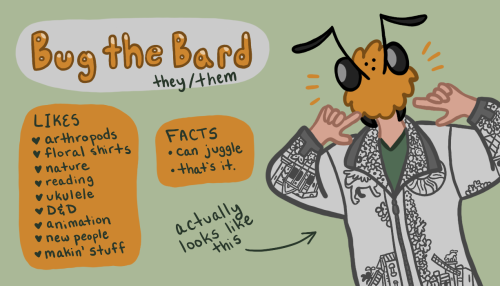
Link to Side Blog Where I Reblog StuffLevel 3 bard, level 1 druid. Figuring out how to make a Master's come out of staring at firebrats.
15 posts
Links:WebsiteKo-Fi

Links: Website🐛Ko-Fi
-
 beetlelady07 liked this · 1 year ago
beetlelady07 liked this · 1 year ago -
 beholding-deez-nuts liked this · 2 years ago
beholding-deez-nuts liked this · 2 years ago -
 snowytiger liked this · 2 years ago
snowytiger liked this · 2 years ago -
 abeetlewithtinyshoes liked this · 2 years ago
abeetlewithtinyshoes liked this · 2 years ago -
 grigadf liked this · 2 years ago
grigadf liked this · 2 years ago -
 skelebee liked this · 2 years ago
skelebee liked this · 2 years ago -
 ahexghoul liked this · 2 years ago
ahexghoul liked this · 2 years ago -
 zekrio liked this · 2 years ago
zekrio liked this · 2 years ago -
 snailsandrocks liked this · 2 years ago
snailsandrocks liked this · 2 years ago -
 nettiereynolds liked this · 2 years ago
nettiereynolds liked this · 2 years ago -
 solemnmagpies liked this · 2 years ago
solemnmagpies liked this · 2 years ago -
 teadrinkingknome liked this · 2 years ago
teadrinkingknome liked this · 2 years ago -
 spiderdaddaz liked this · 2 years ago
spiderdaddaz liked this · 2 years ago -
 nemo-nade liked this · 2 years ago
nemo-nade liked this · 2 years ago -
 bloodhue liked this · 3 years ago
bloodhue liked this · 3 years ago -
 keeskiwi liked this · 3 years ago
keeskiwi liked this · 3 years ago -
 cardussy-connoisseur liked this · 3 years ago
cardussy-connoisseur liked this · 3 years ago -
 dragonatioor liked this · 3 years ago
dragonatioor liked this · 3 years ago -
 huget0ad liked this · 3 years ago
huget0ad liked this · 3 years ago -
 spiderlingbriary reblogged this · 3 years ago
spiderlingbriary reblogged this · 3 years ago -
 spiderlingbriary liked this · 3 years ago
spiderlingbriary liked this · 3 years ago -
 mronedoller liked this · 3 years ago
mronedoller liked this · 3 years ago -
 vesselcollector liked this · 3 years ago
vesselcollector liked this · 3 years ago
More Posts from Bugthebard

Potential application for Mastigoproctus giganteus, the giant vinegaroon.
Vinegaroons are a lesser known order of arachnids, the Thelyponida. They don’t have venom but they can spray acetic acid, the main component of vinegar! Though these funny little critters may look intimidating to some, they’re harmless unless you’re a small prey insect (or you can’t stand the smell of pickles).

neon house centipedes in your house at night (but it's okay because they eat neon cockroaches)

The rather large (by mosquito standards) elephant mosquito, Toxorhynchites rutilus, with jack-in-the-pulpit plants. Designed for a fellow lab member that works with mosquitoes. Though you may not be a mosquito fan, you might like this one - as larvae, they eat other mosquito larvae. As adults, they don't bite but instead both males and females feed on sugary substances.


Dungeons and Dragons is a fun game.



The ground nesting bees have decided the weather is good enough to make an appearance. If you see these lil gals, please let them be(e)! They’re very unlikely to sting (I’ve bothered them so much, no stings) and are great for native plants! iNaturalist suggests to me these particular bees are the unequal cellophane bee, Colletes inaequalis.